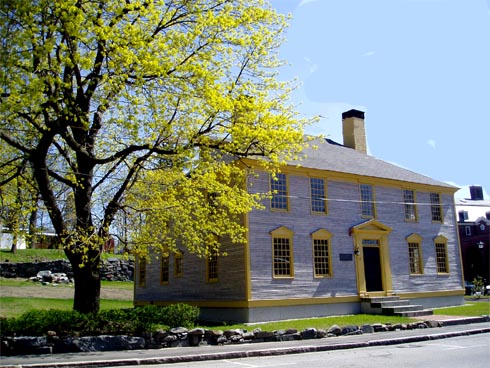| Folsom Tavern Has Moving History |
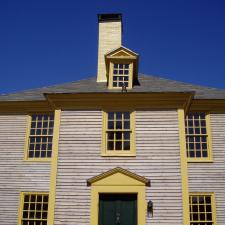
HISTORIC HOUSES
Washington stopped by for breakfast after the Revolutionary War. Since then Exeter, NH’s Folson Tavern has been an inn, a lunch spot, a Chinese laundry, faculty housing, a private residence, a train stop, an antiques store, a dress shop and a shoe repair station. Moved twice, the former "Raleigh" tavern is now an integral part of the American Independence Museum.
American Independence Museum
One Governor's Lane, Exeter, N.H. 03833, 603-772-2622
Open Wednesday - Saturday 10 am – 4 pm, $5 adults, $3 children
Official web site
Moved Twice, Exeter's Revolutionary Tavern is finally Home
Last year the 1775 Folsom Tavern in the village of Exeter, New Hampshire moved 100 feet. That is the short version of the story. But behind this seemingly short journey is a sweeping tale that spans centuries and takes in a dizzying cast of characters including George Washington himself.
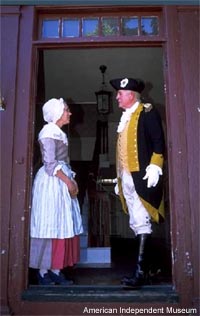 Once a meeting place for patriots during the Revolution, the historic tavern was, until recently, tucked up a downtown side street. Obscured by a row of trees, it was all but invisible to passersby. But in 2005 the American Independence Museum (AIM), the nonprofit owners of the tavern, decided it was time to put Exeter history back on main street.
Once a meeting place for patriots during the Revolution, the historic tavern was, until recently, tucked up a downtown side street. Obscured by a row of trees, it was all but invisible to passersby. But in 2005 the American Independence Museum (AIM), the nonprofit owners of the tavern, decided it was time to put Exeter history back on main street.
"We wanted the tavern to embrace the town again," says John Merkle. "That’s what taverns are supposed to do."
Merkle’s firm TMS Architects orchestrated the recent move, inching the three-story structure down a 15-foot incline to a new granite-faced concrete foundation, clearing trees, restoring rooms and returning the tavern to its 1780s appearance. The work continues, and when it is completed, AIM officials plan to add a modern addition, connecting the tavern to the Ladd-Gilman House (c. 1721) which is even older.
Museum executive director Funi Burdick, herself a trained architect, imagines a history campus on a hill where the town’s Revolutionary story can be told. Among its treasures AIM owns two early drafts of the United States Constitution and a very rare broadside copy of the Declaration of Independence, once read aloud to the citizens of Exeter by John Taylor Gilman in 1776. The Folsom Tavern, in this master plan, will house an educational center up front in the original building, and a secure, modern exhibit hall at the back.
"It all happened right here in Exeter," Burdick says. "The Folsoms and the Gilmans were real players in the creation of America. The Declaration copy was discovered about two decades ago in the attic of the Ladd-Gilman House.
Now we can use these same historic buildings to keep the political discussion going, and to demonstrate that the same dramatic debates are alive today. We are a government that continues to re-invent itself."
The completed campus will accommodate lectures, touring school groups, public meetings, displays, office and research space and outdoor activities – ideally at the same time. Returning the restored Folsom Tavern to Water Street sets in motion an efficient cascade of museum improvements, all focused on the theme of the Revolution.
"It's like re-opening the public debate on how democracy really works, both here and around the world," Burdick says.
Moving colonial buildings is not uncommon in these parts. Our ancestors did it frequently. Milestone Engineering & Construction, Inc. of Concord managed the move, this time with the aid of computerized hydraulic equipment.
"We’ve done this before," says Milestone president Frank Lemay. "It’s very common to pick up old houses to put foundations under them."
His company also recently completed work at the Seacoast Science Center and analyzed the endangered historic North Church steeple in Portsmouth. As structural engineer and construction manager on the Folsom project, Lemay’s firm was also responsible for the tavern’s new foundation, rebuilding chimney bases, replacing old sills, reframing the first floor and a litany of moving-related projects.
Continue MOVING HISTORY in EXETER
EXETER’S INDEPEDNECE MUSEUM (Continued)
The Folsom Tavern, once located across from the famous bandstand in Exeter center, was moved previously. Back in 1929 early Exeter preservationists purchased the building for a dollar and transported it a quarter of a mile down Water Street.
Originally named "The Raleigh", the tavern had already survived many uses by then. The first owner Samuel Folsom and his brother Nathaniel fought in the American Revolution back when Exeter was a hotbed of colonial politics. The New Hampshire Society of the Cincinnati, a private hereditary club for Revolutionary War leaders and named after a Roman general, was founded at the tavern in 1783. Six years later President George Washington, a founding member of the Cincinnati Society, stopped by the Folsom Tavern for breakfast while touring the newly formed nation. His short visit helped inoculate the tavern against destruction.
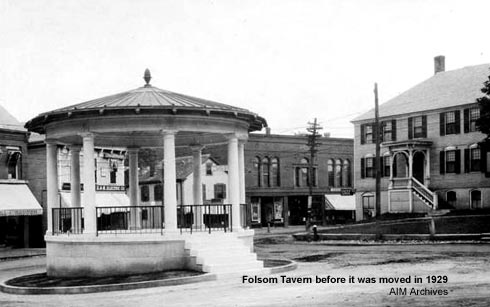
During the heady era following the Revolution, while the founders hammered out the Constitution, Exeter was the temporary capital of New Hampshire. Folsom’s wife Elizabeth later ran the tavern as "Widow Folsom’s Inn" until 1805. After the Civil War, the building was pushed back as Water Street was widened, then raised up so that a brick store could be added below. It became an antiques "curiosity" shop and was later owned by a local "mystic", then transformed into "Washington's Lunch" and a waiting station for the nearby trains and trolley cars. The building served as office space, a Chinese laundry, a milliner's store and a shoe repair shop.
When new owners decided to raze the Folsom Tavern to build a gas station in 1929, the Society of the Cincinnati stepped in to save its New Hampshire birthplace. These descendents of Revolutionary War leaders moved the building. It sat vacant for nearly two decades until preservationist Mrs. Martha Foster Stearns offered to restore the ancient home in 1947 in exchange for the right to live there. The Society agreed.
"She really did a very careful job," Burdick says of Stearns. "Under the guidance of Boston architects, she duplicated early wallpapers, matched crown moldings, and accurately reproduced missing pilasters. We've set aside one room in the tavern in Mrs. Stearns’ honor."
In the early 1950s the building was rented to Phillips Exeter Academy for faculty housing until the creation of the American Independence Museum in 1991. Despite its many uses, John Merkle says, the tavern still retains some of its original 18th century features including the classic front hall and stairway with its hand-turned balustrades. Although plaster walls and ceilings are again being replaced, there are beautiful examples of raised wooden paneling, classical cornices and double-faced doors that Washington himself may have seen.
Even the new location on Water Street proved to be an historic well spring. A team led by archeologist Ellen Marlatt discovered over 1,000 artifacts last fall while testing the ground beneath the new Folsom Tavern site. Many of the items, mostly ceramics, came from the same Revolutionary period when the tavern was built.
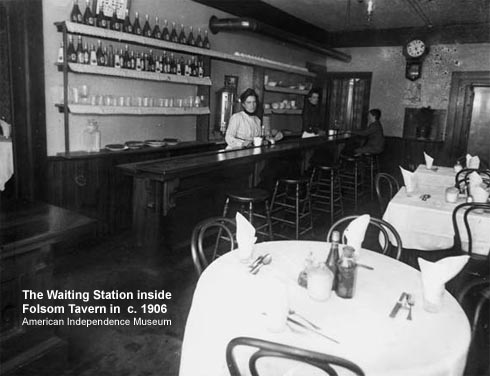
The quality and quantity of this rare archeological evidence, Marlatt says, proves that Exeter in the 1700s was an active seaport much like Portsmouth. Over time, research shows, the new museum site has also seen residential use, merchant shops, a church and an opera house -- all now gone.
Leaving no stone unturned, Burdick also brought on a professional landscape architect to redesign the one-acre downtown site. Robert Hoover says his job was to envision the many outdoor "rooms" in the evolving museum campus.
"Think of the landscape as a pallet, "says Hoover of HBLA, Inc. "Parking lots, walks, plantings, lighting, drainage, grading -- everything you see has to come together as a theme. Here, we want to get the building back to the people."
Hoover commends the work done by Exeter town officials, by Phillips Exeter Academy (founded in 1781), by AIM board members, the civil engineer, by so many volunteers, artisans, researchers, professionals and craftspeople who have gotten this project off the ground.
"This is much more than moving a building," architect Merkle says. "Much, much more."
"And yet," Burdick adds, "if George Washington were to return to Exeter, I like to think, he'd find the familiar Folsom Tavern as welcoming as ever."
C90yrigh © 2006 J. Dennis Robinson. All rights reserved. This article originally appears in Accent Home & Garden Magazine.
